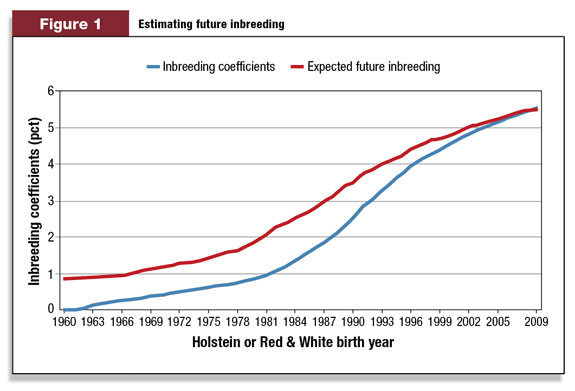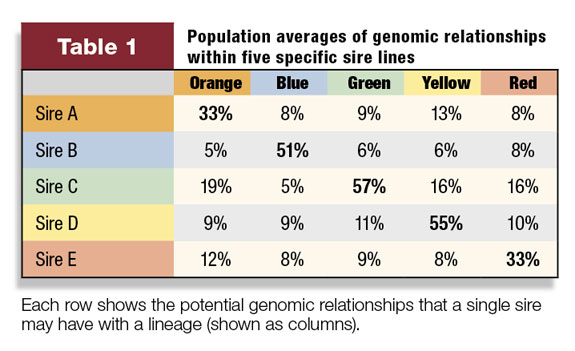The economics of the dairy industry today continue to squeeze the bottom line of every operation. Naturally, expenses and feed rations have been under tremendous scrutiny by every business manager.
Likewise, careful, sound judgments have to be factored into all expenses as to items that are “nice to have” and those that are actually short-term expenses that evolve into a long-term investment.
Genetics and the continuous quest to increase the genetic level of the herd have long been positioned as an investment in the future of the dairy, and it is just that.
However, you may be overlooking the costs and risks associated with careless management of genetics. As a result you could actually be decreasing the profitability of the herd. If a program isn’t put in place to manage inbreeding, it can depress profit and the performance of your operation.
How does inbreeding cost a dairy?
Inbreeding occurs when related animals are mated to one another. Even if a live calf results from this, as cows these individuals have a high likelihood of underachieving fellow herdmates.
The negative effects include decreased health and vigor, lower milk production, reduced reproductive performance, lower embryonic survival rates, decreased calf vigor, increased calf morbidity/mortality and an increased risk of recessive genetic disorders.
It goes without saying that individual herds vary in how they manage the operation, but every dairy operation shares a common goal of profitability. Controlling the level of inbreeding is critical to this goal, no matter what traits drive the greatest profitability for the operation.
More than a decade ago, research done by Dr. Bennet Cassell showed that for each 1 percent inbreeding increase, a herd would experience a reduction of 24 NM$ lifetime performance, an increase of .36 days in age-at-first-calving, a loss of 13 days Productive Life, a loss of 790 pounds of lifetime milk production, 25 pounds of lifetime protein production and a .26-month increase in first- calving interval.
These figures are financially devastating to any herd. The reality is that these figures would likely be significantly higher given present-day performance and genetic statistics.

Not a new challenge
The challenge of inbreeding is not new to the dairy industry or any animal breeding program. The trend of inbreeding has been monitored for years and it is growing at an alarming rate. (See Figure 1 .)
For decades, researchers have studied the results of inbreeding, which have included both admirable advancements in key, desirable traits as well as intensifying risks associated with less desirable and detrimental genetic traits.
Linebreeding, a form of inbreeding, has been used in the art of elite cattle breeding for years. By definition, it is the intentional mating of closely related individuals to create offspring with the potential to have a greater intensity of superior traits from these two parents who inherited their traits from common ancestry.
The slight difference between inbreeding and linebreeding is that linebreeding is the act of intentionally taking the risk. Inbreeding occurs without conscious choice, simply due to the intensity of common ancestors that have shaped the breed.
Many genetic and cattle breeding advancements share a common, historical pattern of at first greatly improving the options that help reduce inbreeding, but then, in turn, leading to a longer-term intensification of the inbreeding challenge.
For example, even the earliest forms of genetic evaluation led to dairy producers broadening their search for new herd sires, seeking sons and grandsons of those sires demonstrating an ability to sire higher-producing offspring.
In the short term, bringing in more and more outside genetic influences to the herd minimized inbreeding. But the demand for these better bloodlines also drove the demand for more intensification of their genetics and, in turn, reduced – to some extent – the genetic variation available for future generations.
Artificial insemination is another great example. With the perfection of this technology, the breadth of genetic selection once again allowed dairy producers a great selection of genetics to bring into their herd.
Early use of it brought in new bloodlines and genetics, but the new means to extend distribution of the very best bulls intensified the demand for the genetics of them and their sons and grandsons, leading to a reduction in the gene pool overall.
Genomics – a new example
Is genomic testing the latest example of a technology that offers short-term benefit and longer-term challenges? This is very likely true. At the time genomic testing was introduced, it debuted with the promise of finding more outlying pedigrees that could refresh the gene pools of dairy breeds. In many instances, it did just that – early on.
But, in time, the use of genomic testing has intensified the use of the more familiar and superior pedigrees. However, there are still ways we can benefit from genomics, without repeating the same cycle and resulting in the same challenges.
The use of genomic evaluations further pinpoints the exact genes an individual animal possesses, indicating the proportion inherited from each parent, grandparent or other ancestor. The thoughtful, strategic and committed use of this tool can help categorize sires based on common genetic traits, regardless of the sire’s parentage.
This, then, allows the application of the insight gained from this modern technology to select and plan sire sequences that will both achieve herd genetic performance goals and reduce inbreeding within the herd.

Table 1 shows population averages of genomic relationships within five specific sire lines.
Achieving this level of sophistication and creating a simple program that all dairy producers can use to improve their herds’ performance and minimize the losses associated with inbreeding requires significant, long-term sire program development and an ongoing commitment to continue building genomic lines that fit such a program approach to breeding.
However, by doing so, we can change the cycle of inbreeding challenges and, at the same time, fully benefit from new technologies, such as genomic testing of progeny development and daughter-proven sires. PD

-
Jeff Ziegler
- Genomics Program Manager
- Select Sires,Inc.
- Email Jeff Ziegler








